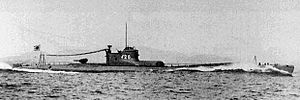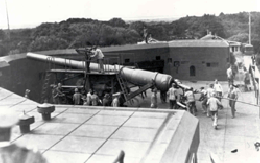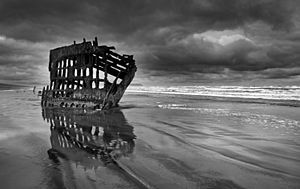Bombardment of Fort Stevens facts for kids
Quick facts for kids Bombardment of Fort Stevens |
|||||||
|---|---|---|---|---|---|---|---|
| Part of the American theater and the Pacific Theater of World War II | |||||||
 American servicemen inspecting a shell crater after the Japanese attack on Fort Stevens. |
|||||||
|
|||||||
| Belligerents | |||||||
| Commanders and leaders | |||||||
| unknown | Akiji Tagami | ||||||
| Strength | |||||||
| Land: 2 artillery pieces 1 fort Air: 1 aircraft |
1 submarine | ||||||
| Casualties and losses | |||||||
| Minor damage | None | ||||||
The Bombardment of Fort Stevens happened in June 1942 during World War II. A Japanese submarine, the I-25, fired shells at Fort Stevens in Oregon. This fort was on the Columbia River near the Pacific Ocean. It was the only time during World War II that an enemy attacked a military base in the main part of the United States.
Contents
What Was the Fort Stevens Attack?
This event was part of the larger American Theater and Pacific Theater of World War II. It showed that the war could reach the American mainland. Even though the damage was small, it caused a lot of worry on the West Coast.
The Japanese Submarine's Mission
The Imperial Japanese Navy submarine I-25 was led by Commander Akiji Tagami. Its main job was to sink enemy ships. It also had a large 14 cm deck gun to attack targets on land. The submarine carried a small Yokosuka E14Y seaplane and had a crew of 97 sailors.
On June 21, 1942, the I-25 entered the waters near the U.S. coast. It followed fishing boats to avoid hidden mines. This helped it get close to the shore without being detected.
The Attack on Fort Stevens
Late that night, Commander Tagami ordered his submarine to come to the surface. Their target was Fort Stevens, a historic fort built during the American Civil War. The fort had older artillery, like 12-inch mortars and 10-inch and 6-inch disappearing guns.
Tagami told his crew to start firing their deck gun at Battery Russell, a part of Fort Stevens. Surprisingly, most of the Japanese shells did not cause much harm. The fort's commander quickly ordered a total blackout. This made it harder for the submarine to see its targets.
The fort's commander also decided not to fire back. He knew that returning fire would show the submarine exactly where they were. The fort's equipment showed that the submarine was too far away for their guns to hit it anyway.
Most of the Japanese shells landed in a nearby baseball field or a swamp. One shell landed close to Battery Russell. Another hit near a concrete pillbox. The only real damage was when one shell cut several large telephone cables. In total, the submarine fired 17 explosive shells at the fort.
The American Response
United States Army Air Forces planes were on a training flight when they spotted the I-25. They quickly reported its location. An A-29 Hudson bomber was sent to attack the submarine.
The bomber found the I-25. However, the submarine was able to move quickly and avoid the bombs. The I-25 then went underwater and escaped without any damage.
What Happened After the Attack?
Even though no one was hurt and there was very little damage, the attack caused a big scare. People on the West Coast worried about a full-scale invasion in 1942. This fear was also fueled by the Aleutian Islands Campaign happening around the same time.
Because of these worries, rolls of barbed wire were put up along the coast. They stretched from Point Adams, near the Columbia River, southward. This was to stop any enemy soldiers who might try to land. The old shipwreck of the British barque Peter Iredale got tangled in this wire. It stayed that way until the war ended.
Why Was This Attack Important?
The shelling of Fort Stevens was a unique event in World War II. It was the only time that a military base in the contiguous United States was attacked by the Axis Powers. It was also the second time a military base in the main U.S. was attacked by an enemy during the war. The first was the bombing of Dutch Harbor in Alaska, which happened two weeks earlier.




